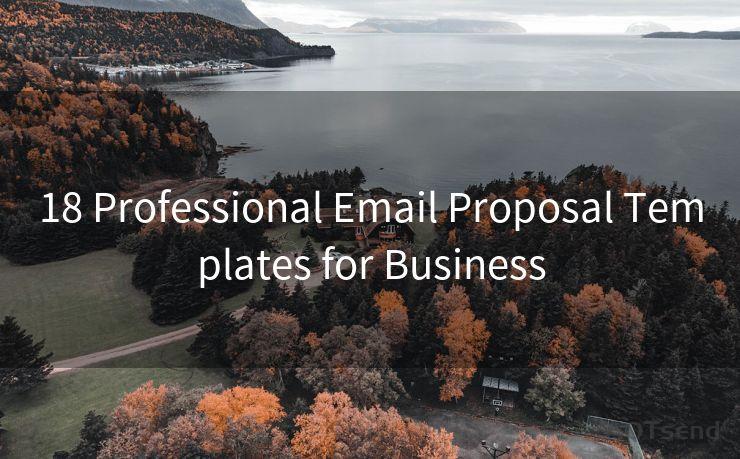19 Mail Alert App Best Practices




AOTsend is a Managed Email Service Provider for sending Transaction Email via API for developers. 99% Delivery, 98% Inbox rate. $0.28 per 1000 emails. Start for free. Pay as you go. Check Top 10 Advantages of Managed Email API
In today's digital age, email alerts have become an integral part of our daily communication. Whether it's for business, personal use, or emergency notifications, a reliable mail alert app can make all the difference. Here are 19 best practices to consider when creating or optimizing your mail alert app for maximum efficiency and user satisfaction.
1. Clear and Concise Notifications
Ensure that your mail alert notifications are clear, concise, and to the point. Users should be able to quickly understand the content and urgency of the message without having to open the email itself.
2. Customizable Settings
Provide users with the ability to customize their notification settings. This includes the ability to choose which types of emails trigger alerts, the sound of the alert, and even the ability to schedule quiet hours.
3. Timely Alerts
Timeliness is crucial. Your app should deliver alerts as soon as new emails arrive, ensuring users are always up to date.
4. Battery Optimization
Design your app to be battery-friendly. Frequent notifications shouldn't drain the user's battery too quickly. Implement push notifications efficiently to minimize battery usage.

5. User-Friendly Interface
The interface of your mail alert app should be intuitive and user-friendly. Make it easy for users to navigate and manage their notifications.
6. Secure Encryption
Given the sensitivity of email content, it's essential to ensure that all notifications are securely encrypted, protecting user privacy.
7. Integration with Multiple Email Providers
Your app should have the capability to integrate with various email providers, giving users flexibility and convenience.
8. Smart Filtering
Implement smart filtering options that allow users to block or allow notifications based on specific criteria, such as sender, subject, or even keywords in the email body.
9. Cross-Platform Compatibility
Ensure your mail alert app is compatible with multiple operating systems and devices, including iOS, Android, and desktop platforms.
10. Offline Accessibility
Provide offline access to notifications, allowing users to view past alerts even without an internet connection.
11. Interactive Notifications
Make notifications interactive, allowing users to respond directly from the notification itself, improving efficiency and user experience.
12. Detailed Logging and History
Maintain a detailed log and history of all notifications, enabling users to easily track and reference past alerts.
13. Cloud Synchronization
Offer cloud synchronization, so users can access their notifications across multiple devices.
14. Easy Unsubscribe Options
Include an easy way for users to unsubscribe from unwanted notifications, reducing clutter and improving the overall user experience.
15. Support for Multiple Languages
Support for multiple languages ensures your app caters to a wider audience.
16. Regular Updates
Regularly update your app to fix bugs, improve performance, and add new features based on user feedback.
17. Tutorial and Help Section
Include a comprehensive tutorial and help section to guide new users through the app's features and settings.
18. Feedback Mechanism
Provide a feedback mechanism for users to report issues or suggest improvements, enabling you to continuously refine your app.
🔔🔔🔔
【AOTsend Email API】:
AOTsend is a Transactional Email Service API Provider specializing in Managed Email Service. 99% Delivery, 98% Inbox Rate. $0.28 per 1000 Emails.
AOT means Always On Time for email delivery.
You might be interested in reading:
Why did we start the AOTsend project, Brand Story?
What is a Managed Email API, Any Special?
Best 25+ Email Marketing Platforms (Authority,Keywords&Traffic Comparison)
Best 24+ Email Marketing Service (Price, Pros&Cons Comparison)
Email APIs vs SMTP: How they Works, Any Difference?
19. Accessibility Features
Ensure your app is accessible to all users, including those with disabilities, by implementing accessibility features such as screen reader compatibility and high contrast modes.
By following these best practices, you can create a mail alert app that is not only efficient and user-friendly but also secure and accessible to all. Remember, the key to a successful app lies in its ability to meet the needs and preferences of its users, so always prioritize user feedback and continue to refine and improve your app accordingly.




AOTsend adopts the decoupled architecture on email service design. Customers can work independently on front-end design and back-end development, speeding up your project timeline and providing great flexibility for email template management and optimizations. Check Top 10 Advantages of Managed Email API. 99% Delivery, 98% Inbox rate. $0.28 per 1000 emails. Start for free. Pay as you go.
Scan the QR code to access on your mobile device.
Copyright notice: This article is published by AotSend. Reproduction requires attribution.
Article Link:https://www.aotsend.com/blog/p6972.html











